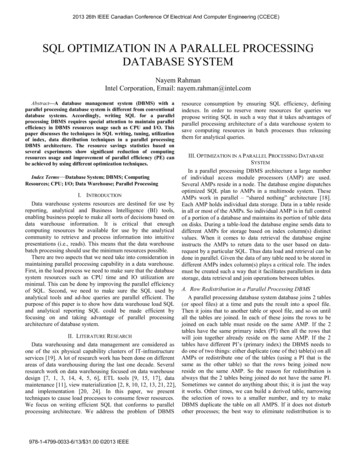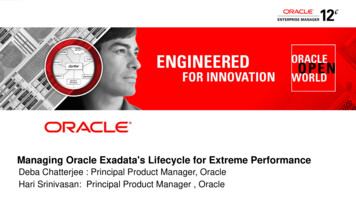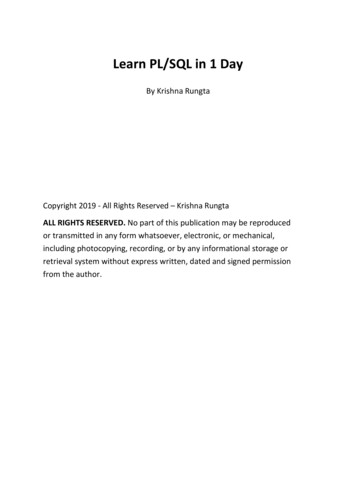
Transcription
2013 26th IEEE Canadian Conference Of Electrical And Computer Engineering (CCECE)SQL OPTIMIZATION IN A PARALLEL PROCESSINGDATABASE SYSTEMNayem RahmanIntel Corporation, Email: nayem.rahman@intel.comAbstract—A database management system (DBMS) with aparallel processing database system is different from conventionaldatabase systems. Accordingly, writing SQL for a parallelprocessing DBMS requires special attention to maintain parallelefficiency in DBMS resources usage such as CPU and I/O. Thispaper discusses the techniques in SQL writing, tuning, utilizationof index, data distribution techniques in a parallel processingDBMS architecture. The resource savings statistics based onseveral experiments show significant reduction of computingresources usage and improvement of parallel efficiency (PE) canbe achieved by using different optimization techniques.Index Terms—Database System; DBMS; ComputingResources; CPU; I/O; Data Warehouse; Parallel ProcessingI. INTRODUCTIONData warehouse systems resources are destined for use byreporting, analytical and Business Intelligence (BI) tools,enabling business people to make all sorts of decisions based ondata warehouse information. It is critical that enoughcomputing resources be available for use by the analyticalcommunity to retrieve and process information into intuitivepresentations (i.e., reads). This means that the data warehousebatch processing should use the minimum resources possible.There are two aspects that we need take into consideration inmaintaining parallel processing capability in a data warehouse.First, in the load process we need to make sure that the databasesystem resources such as CPU time and IO utilization areminimal. This can be done by improving the parallel efficiencyof SQL. Second, we need to make sure the SQL used byanalytical tools and ad-hoc queries are parallel efficient. Thepurpose of this paper is to show how data warehouse load SQLand analytical reporting SQL could be made efficient byfocusing on and taking advantage of parallel processingarchitecture of database system.resource consumption by ensuring SQL efficiency, definingindexes. In order to reserve more resources for queries wepropose writing SQL in such a way that it takes advantages ofparallel processing architecture of a data warehouse system tosave computing resources in batch processes thus releasingthem for analytical queries.III. OPTIMIZATION IN A PARALLEL PROCESSING DATABASESYSTEMIn a parallel processing DBMS architecture a large numberof individual access module processors (AMP) are used.Several AMPs reside in a node. The database engine dispatchesoptimized SQL plan to AMPs in a multimode system. TheseAMPs work in parallel – “shared nothing” architecture [18].Each AMP holds individual data storage. Data in a table residein all or most of the AMPs. So individual AMP is in full controlof a portion of a database and maintains its portion of table dataon disks. During a table-load the database engine sends data todifferent AMPs for storage based on index column(s) distinctvalues. When it comes to data retrieval the database engineinstructs the AMPs to return data to the user based on datarequest by a particular SQL. Thus data load and retrieval can bedone in parallel. Given the data of any table need to be stored indifferent AMPs index column(s) plays a critical role. The indexmust be created such a way that it facilitates parallelism in datastorage, data retrieval and join operations between tables.A. Row Redistribution in a Parallel Processing DBMSA parallel processing database system database joins 2 tables(or spool files) at a time and puts the result into a spool file.Then it joins that to another table or spool file, and so on untilall the tables are joined. In each of these joins the rows to bejoined on each table must reside on the same AMP. If the 2tables have the same primary index (PI) then all the rows thatII. LITERATURE RESEARCHwill join together already reside on the same AMP. If the 2Data warehousing and data management are considered as tables have different PI’s (primary index) the DBMS needs toone of the six physical capability clusters of IT-infrastructure do one of two things: either duplicate (one of the) table(s) on allservices [19]. A lot of research work has been done on different AMPs or redistribute one of the tables (using a PI that is theareas of data warehousing during the last one decade. Several same as the other table) so that the rows being joined nowresearch work on data warehousing focused on data warehouse reside on the same AMP. So the reason for redistribution isdesign [7, 1, 3, 14, 4, 5, 6], ETL tools [9, 15, 17], data always that the 2 tables being joined do not have the same PI.maintenance [11], view materialization [2, 8, 10, 12, 13, 21, 22], Sometimes we cannot do anything about this; it is just the wayand implementation [20, 24]. In this paper, we present it works. Other times, we can build a derived table, narrowingtechniques to cause load processes to consume fewer resources. the selection of rows to a smaller number, and try to makeWe focus on writing efficient SQL that conforms to parallel DBMS duplicate the table on all AMPS. If it does not disturbprocessing architecture. We address the problem of DBMS other processes; the best way to eliminate redistribution is to978-1-4799-0033-6/13/ 31.00 2013 IEEE
build the tables being joined with the same PI (this is notalways possible).B. Duplicating on All AMPs & Product JoinIf table-joins have different PI’s or they contain skewed data,DBMS copies data to all AMPs for parallel processing. Wecannot avoid it in many situations. To ensure that theduplication takes less resources temporary tables could be usedwith reduced row and column numbers. Product Join happenswhen a ‘JOIN’ occurs between a large and a small table. Toimprove performance two things can be done: narrow down therows and columns of that small table; if the smaller tablecontains static data with few records in that case column valuescould be placed in memory variables. That way the JOIN withthe smaller table could be entirely eliminated.C. Primary Index (PI) Choice CriteriaThe primary index selection should be based on data access,distribution and volatility. In regards to access demographics,columns that would appear with a value in a WHERE clauseneed to be considered. Need to choose the column mostfrequently used for access to maximize the number of oneAMP operations. To ensure data distribution demographics themore unique the index values, the better the distribution. Toavoid data volatility, the data values should not often changefor an index column. Any changes to PI values may result inheavy I/O overhead. Join activity against the PI definition. Forlarge tables, the number of distinct Primary Index values shouldbe much greater than the number of AMPs.D. Sync up Source & Target Table PI’sCommon PI’s between source and target tables help bulkinserts. The DBMS optimizer performs PI-based MERGEJOINs. In a large join operation, a merge join requires less I/OCPU time than nested join. A merge join usually reads eachblock of the INNER table only once, unless a large number ofhash collisions occur. In a real world scenario we noticed thatdue to missing common PI’s the SQL of a stored procedurebecame 90% skewed. It pulled records from two large tableswith several join columns. Run time was 5 hours and 6 minutesto load 9 million rows. After PI synchronization the run-timedropped to 1 minute 11 seconds.E. Global Temporary Tables vs. Derived TablesThe solution to some of the resource intensive queriesincludes conversion of a derived table (DT) to a globaltemporary table (GTT). This is because the GTT can havestatistics collected whereas the DT cannot. The GTT approachmakes the optimizer plans more aggressive and rely moreheavily on collected stats as opposed to sampled statistics. Asin all of life, there is trade-offs: relying on collected stats wouldproduce better running queries than the random samples. Withdata skew, the random samples were often wrong and causedwrong choices to be made. We can achieve better performanceplans for tables (GTT) with collected statistics. We cannotcollect statistics on derived or volatile tables so these do notperform as well. Figure 1 shows performance results of an SQLthat used derived tables. The result shows that per evaluationcriteria the SQL failed in terms of computing resources usagesuch as CPU, IO and spool space usage. Their parallelefficiencies are very poor.Fig. 1 Resource Usage with an SQL that uses derived tables.Figure 2 shows that each SQL passed in terms ofperformance evaluation criterion. Computing resourcesconsumption such CPU, IO and spool usage is much lowercompared to the resources used shown in Figure 3. Each SQLalso shows that they higher parallel efficiency.Fig. 2 Resource Usage with SQL’s that use GTT.F. Avoid UPDATE Between Large TablesUpdate is good when source table has fewer rows.Fig. 3 Typical Update to narrow down the rows.In one experiment we noticed that the UPDATE operation byjoining large source table caused CPU consumption of 1,013seconds. Using a subset of data from large tables with globaltemporary tables will help in computing resource saving. In asimulation we noticed that by using global temporary table for asub-set of data in source table the UPDATE operation took only600 CPU seconds. This indicates a 50% reduction in computingresources consumption.G. Partitioned Primary Index (PPI)It is a good idea to use Partitioned Primary Indexes (PPI)whenever possible. The score-card result shows betterperformance when rows are retrieved based on PPI defined on adate column (for instance). Queries which specify a restrictivecondition on the partitioning column avoid full table scans as
distinct PPI-based column values are stored in buckets. Largertables are good candidates for partitioning. The greatestpotential gain derived from partitioning a table is the ability toread a small subset of the table instead of the entire table.In a PPI-defined table a query with filters on PPI column willdirectly pull data based on particular bucket(s) instead ofscanning the whole table. In Figure 4 we show a comparison ofperformance metrics by performing SQL scorecard analysis ofboth PPI and non-PPI tables. The experiment results show thatthe SQL with PPI defined uses only 4.64% of the resources topull rows from a PPI table compared to a non-PPI table. Thissignificant amount of resource savings (95.36%) was possibledue to ability to read a small subset of data using partitioning inthe table instead of scanning the entire table.Fig. 4 Resource Usage: PPI vs. No PPI tables.Figure 4 shows a comparison of query response time andcomputational resource savings between PPI and No-PPIqueries. The first query was run to pull 1972 rows, with no PPIdefined. The response time was 29 seconds and CPUconsumption was 1,121 seconds in row one. The first rowshows that failed scorecard process. It was using too muchresources and spool space for the query it pulled. The joinswere exposed to too much data in source tables as opposed torows being pulled. The same query was run against the sametable but with PPI defined on a date field. For the second runthe response time was two seconds and resource consumptionwas 52 seconds for row two. In this case, database optimizerpulled the rows based on PPI defined on the date field.The database technology is available on the market for thelast three decades. The commercial database companies havecome up with several indexing techniques. The PPI technique isconsidered as one of the efficient indexing used in parallelprocessing database systems.IV. PARALLEL EFFICIENCY AND DBMS RESOURCE USAGEA parallel processing DBMS system plays two importantroles towards maintaining an efficient data warehouse system.First, it helps running load, reporting, and ad-hoc queries fasterthan queries of traditional data warehouse system. Datawarehouses hold mostly historical data of a business enterprise.Most of the tables in a data warehouse hold a large volume ofdata. Refreshing these large tables, running queries againstlarge volume of data require significant processing capability ofa data warehouse system. If a data warehouse system cannotload millions of rows within an SLA that increases data latencybetween operational database and the data warehouse [16]. Thisimpacts tactical decision making capability of management. Onthe other hand, if a data warehouse cannot return query resultswithin a reasonable time – (less than five minutes) thenreporting capability of business tools is impacted. Slowness of adatabase system is not acceptable to the analytical community.A parallel efficient database system allows pulling rows muchfaster.In a parallel processing database system SQL needs to bewritten in such a way that it takes advantage of parallelprocessing architecture of DBMS system. In a real worldapplication the author of this paper observed that in many casesthe application developers failed to realize they need to takeinto consideration the parallel processing architecture in writingSQL queries. This hurts the database system because in mostcases the user query goes to a few machines as opposed to allmachines available to process a query in parallel. When thathappens system becomes skewed. SQL sent to those fewmachines struggle to handle a query while other availablemachines are sitting idle and end up using abnormally highamount of resources. We did some experiments betweenconventional queries and queries written in compliance withparallel processing database system. We have taken severalmeasures such as use of indexes for data accessibility and datadistribution to different machines while loading; use of globaltemporary tables to stage required with an amount of rows tomake join operations efficient; synch up source and target tableindices based on join columns and avoid expensive rowredistribution on the fly while loading or retrieving rows; use ofpartitioned primary index allow queries to retrieve rows fromthe data warehouse directly from a specified location byavoiding all-rows scan; and use of global temporary tables (toenable collection of statistics) and avoid using derived tables(consisting of SQL on the fly) to prepare for join operations.TABLE I: Computing Resource Consumption: ASIS vs.OptimizedTable-1 shows the variation of computing resourceconsumption by an as-is version vs. Optimized version. In as-isversion the stored procedure SQL was using derived tables inSQL which caused missing statistics. As a result JOINoperations were suffering from performance issue. Collectionof statistics is very important to improve parallel efficiency. Itprovides database parser engine to come up with a plan that iscost efficient for the requested SQL. Collects statistics providesinformation as to how many rows it is going to access duringjoin operation. To overcome missing statistics issue in derivedtables in SQL we removed the derived table from the SQL. Weused global temporary tables instead which allowed us tocollect statistics on join and filter columns. So, the as-is versionof SQL that used derived tables in SQL caused spool spaceincrease (virtual space) due to missing statistic in derived tableswhile performing join operations. In table 1, we can see the firstrow shows huge spool usage (in red) and a spool parallelefficiency of 70.75% only. This has caused overall SQLscorecard failure. On the other hand, the second row in the tableshows a significant amount of spool space reduction. This has
been achieved by removing derived table from the SQL andusing temporary tables (with collect stats) instead. The secondrow in the table also shows significant improvement of spoolparallel efficiency (90.9%).TABLE III: Computing Resource Consumption: ASIS vs.Optimizedtemporary tables are useful for run-time use and they do notneed journaling and hence, helps in loading analytical tableefficiently. In our experimental results we showed that writingSQL in compliance with parallel processing architecture helpsin improving SQL performance and allows for saving CPU, IOand spool space usage.ACKNOWLEDGMENTSThe author wishes to thank the anonymous referees for thetime they spent on the detailed comments that were helpful inimproving this paper. The author also thanks Joan Schnitzer foran excellent editing job.REFERENCESIn Table-2, the first row shows the scorecard results of an asis SQL version. It shows that the scorecard failed in terms ofCPU consumption, IO generation and IO parallel efficiency;and spool usage and spool parallel efficiency. In this SQL thecolumns were not based on index columns, each source tablehad a large number of rows but not all data needed from userstandpoint and also not all source columns needed for this fromuser standpoint. So, before making joins to eight large sourcetables we decided to use global temporary tables to stagerequired rows and columns from each of the source tables. Inbuilding the global temporary tables we made sure that joincolumns are reflected in the index to increase PE during table.Rows two to eight in Table II show a very small amount ofcomputing resource consumption for staging data in each of thetemporary tables. They also show the scorecard passed for eachin terms of CPU, IO and spool space usage and their respectiveparallel efficiency. We also noticed that resource consumptionhas dropped and parallel efficiency has improved significantly.The last row in Table II shows the final SQL consisting joins toall temporary tables loaded under rows two to eight. As eachtemporary table holds a very small amount of rows and requiredfields only the join performance and overall load performanceof SQL looks very impressive (the last 9 rows in Table II). Thetable shows a savings of 1072 (1285 - 213) CPU seconds. Thus,we can see that SQL written in compliance with parallelprocessing architecture of database system helps in improvingdata load and retrieval performance.[1]V. CONCLUSIONIn this paper we assert that writing SQL for a parallelprocessing database system is not the same as it is for atraditional database system. The purpose of this paper is topoint out the areas that an SQL developer needs to look at tocomply with parallel processing architecture of underlyingdatabase system. This helps in achieving two important goals ina data warehousing system. One is to make sure minimalamount of computing resources is used. This is needed to keepdata warehousing environment stable and healthy. The othergoal is to allow the databases engine retrieve query resultswithin a few seconds. Response time is the key to analyticalcommunity [23]. We have proposed a few techniques toimprove parallel efficiency such as avoid using derived tablesso statistics of join and filter column values do not get lost. Wehave also come up with techniques for writing SQL in smallblocks with the help of global temporary tables. The [15][16][17][18]N. Rahman, J. Marz, and S. Akhter, “An ETL Metadata Model for DataWarehousing,” Journal of Computing and Information Technology (CIT).Volume 20, No 2, 2012, Pages, 95-111, 2012.R. Chirkova, Li, Li, and J. Li, “Answering Queries using MaterializedViews with Minimum Size”. The VLDB Journal, 15(3), 191-210, 2006.D. Dey, Z. Zhang and P. De, P., “Optimal Synchronization Policies forData Warehouse”, Information Journal on Computing, 18(2), 229-242,2006/J. Evermann, “An Exploratory Study of Database Integration Processes”.IEEE Transactions On Knowledge and Data Engineering, 20(1), 2008J. García-García and C. Ordonez, “Extended aggregations for databaseswith referential integrity issues”. Data & Knowledge Engineering, 69,73–95, 2010.T. Georgieva, “Discovering Branching and Fractional Dependencies inDatabases”. Data & Knowledge Engineering, 66, 311-325, 2008.J.H. Hanson and M.J. Willshire, “Modeling a faster data warehouse”.International Database Engineering and Applications Symposium(IDEAS 1997).D.H. Hwang and H. Kang, “XML View Materialization with DeferredIncremental Refresh: the Case of a Restricted Class of Views”. Journalof Information Science and Engineering, 21, 1083-1119, 2005.A. Karakasidis, P. Vassiliadis and E. Pitoura, “ETL Queues for ActiveData Warehousing”. In Proceedings of the 2nd International Workshopon Information Quality in Information Systems, IQIS 2005, Baltimore,MD, USA, 2005.T. Kim, J. Kim and H. Lcc, “A Metadata-Oriented Methodology forBuilding Data warehouse: A Medical Center Case”. Informs & Korms,Seoul, Korea, 2000.W. Labio, J. Yang, Y. Cui, H. Garcia-Molina and J. Widom,“Performance issues in Incremental Warehouse Maintenance”. InProceedings of the VLDB, Cairo, Egypt, 2000.K.Y. Lee, J.H. Son and M.H. Kim, “Efficient Incremental ViewMaintenance in Data Warehouses”. In Proceedings of the TenthInternational Conference on Information and Knowledge Management(CIKM'01), Atlanta, Georgia, USA, 2001.M. Mohania and Y. Kambayashi, “Making Aggregate Views SelfMaintainable”. Journal of Data and Knowledge Engineering, 32(1), 87 –109, 2000.P. Ram and L. Do, “Extracting Delta for Incremental Data WarehouseMaintenance”. In Proceedings of the 16th International Conference onData Engineering, San Diego, CA, 2000.H. Schwarz, R. Wagner and B. Mitschang, “Improving the Processing ofDecision Support Queries: The Case for a DSS Optimizer”. Inproceedings of the International Database Engineering & ApplicationsSymposium. (IDEAS '01), 2001.M.A. Sharaf and P.K. Chrysanthis, “Optimizing I/O-IntensiveTransactions in Highly Interactive Applications”. In Proceedings of the35th SIGMOD international conference on Management of data,Providence, Rhode Island, USA, 785-798, 2009.A. Simitsis, P. Vassiliadis and T. Sellis, “Optimizing ETL Processes inData Warehouses”. In Proceedings of the 21st International Conferenceon Data Engineering (ICDE'05).and Knowledge Management(CIKM'01), Atlanta, Georgia, USA., 2005.T. Koffing, "Teradata Architecture", Retrieved on 01/06/2012 from:http:// www.coffingdw.com/sql/tdsqlutp/teradata architecture.htm
[19][20][21]W. Weill, M. Subramani and M. Broadbent, “Building IT Infrastructurefor Strategic Agility”. MIT Sloan Management Review, 2002.J. Widom, “Research Problems in Data Warehousing”. In proceedings ofthe 4th Int'l Conference on Information and Knowledge Management(CIKM), 1995.Y. Zhuge, H. García-Molina, J. Hammer and J. Widom, “ViewMaintenance in a Warehousing Environment”. In Proceedings of the1995 ACM SIGMOD International Conference on Management of Data(SIGMOD’95), San Jose, CA USA, 1995.[22][23][24]Y. Zhuge, J.L. Wiener and H. Garcia-Molina, “Multiple ViewConsistency for Data Warehousing”. In Proceedings of the ThirteenthInternational Conference on Data Engineering, Birmingham U.K.andKnowledge Management (CIKM'01), Atlanta, Georgia, USA, 1997.N. Rahman, “Refreshing Data Warehouses with Near Real-TimeUpdates,” Journal of Computer Information Systems, 2007, Volume 47,Part 3, Pages 71-80, 2007.N. Rahman, “Saving DBMS Resources While Running Batch Cycles inData Warehouses,” International Journal of Technology Diffusion(IJTD), 2010, Volume 1, Issue 2, Pages 42-55, 2010.
Data warehousing and data management are considered as one of the six physical capability clusters of IT-infrastructure services [19]. A lot of research work has been done on different areas of data warehousing during the last one decade. Several research work on data warehousing focused on data warehouse











